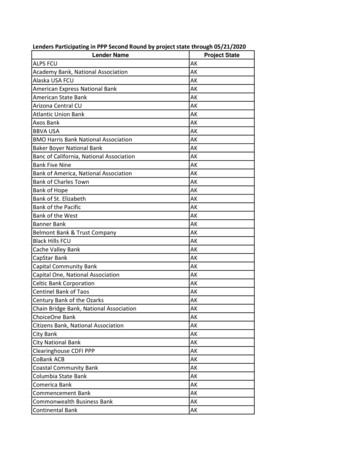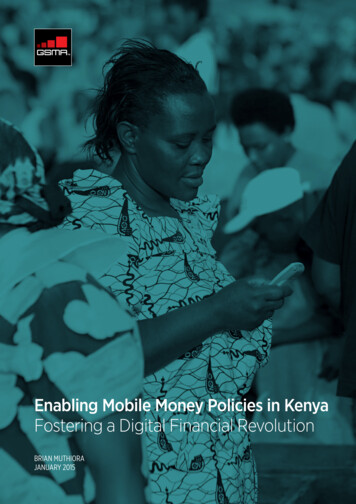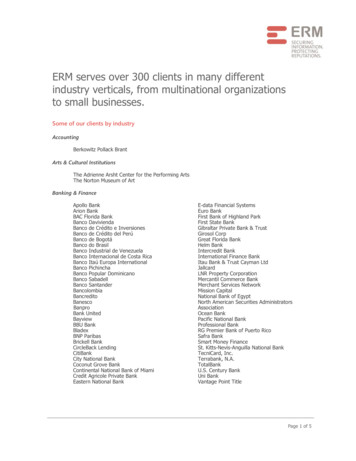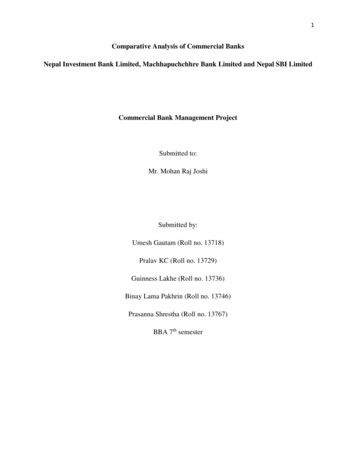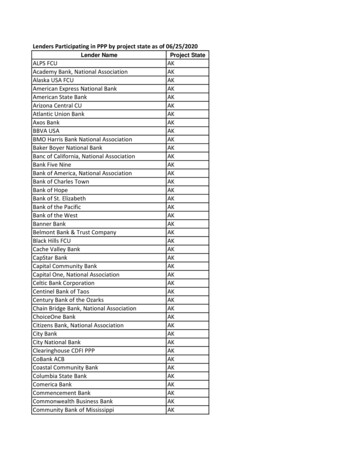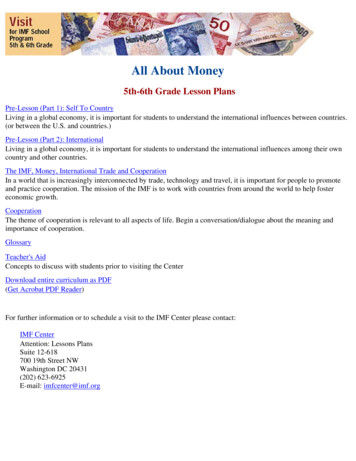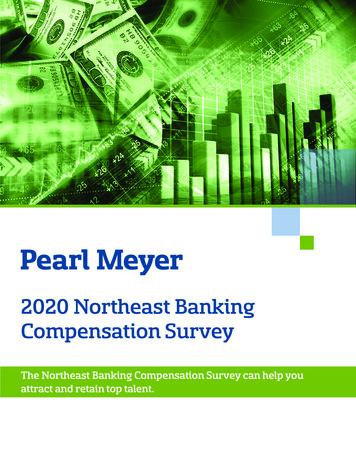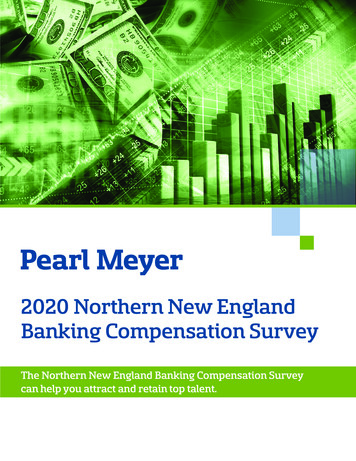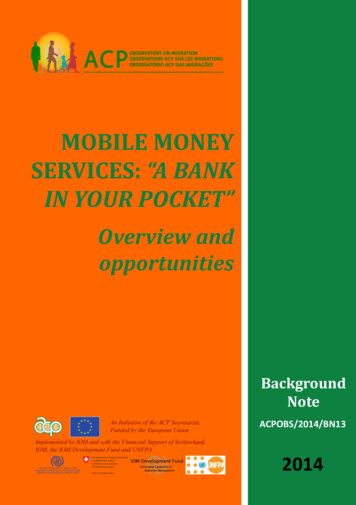
Transcription
OBSERVATORY ON MIGRATIONOBSERVATOIRE ACP SUR LES MIGRATIONSOOBSERVATÓRIOACP DAS MIGRAÇÕESmobile moneyservices: “A bankin your pocket”Overview andopportunitiesBackgroundNoteAn Initiative of the ACP Secretariat,Funded by the European UnionImplemented by IOM and with the Financial Support of Switzerland,IOM, the IOM Development Fund and UNFPAInternational Organization for Migration (IOM)Organisation internationale pour les migrations (OIM)Organização Internacional para as Migrações (OIM)ACPOBS/2014/BN132014
ACP Observatory on MigrationThe ACP Observatory on Migration is an initiative of the Secretariat of the African, Caribbean andPacific (ACP) Group of States, funded by the European Union, implemented by the InternationalOrganization for Migration (IOM) in a Consortium with 15 partners and with the financialsupport of Switzerland, IOM, the IOM Development Fund and UNFPA. Established in 2010, theACP Observatory is an institution designed to produce data on South-South ACP migration formigrants, civil society and policymakers and enhance research capacities in ACP countries for theimprovement of the situation of migrants and the strengthening of the migration–developmentnexus.The Observatory was established to facilitate the creation of a network of research institutionsand experts on migration research. Activities are starting in 12 pilot countries and will beprogressively extended to other interested ACP countries. The 12 pilot countries are: Angola,Cameroon, the Democratic Republic of the Congo, Haiti, Kenya, Lesotho, Nigeria, Papua NewGuinea, Senegal, Timor‐Leste, Trinidad and Tobago and the United Republic of Tanzania.The Observatory has launched research and capacity‐building activities on South-South migrationand development issues. Through these activities, the ACP Observatory aims to address manyissues that are becoming increasingly important for the ACP Group as part of the migrationdevelopment nexus. Documents and other research outputs and capacity‐building manualscan be accessed and downloaded free of charge through the Observatory’s website (www.acpmigration‐obs.org). Other upcoming publications and information on the Observatory’sactivities will be posted online. 2014 International Organization for Migration (IOM) 2014 ACP Observatory on MigrationDocument prepared by María Paula Subia and Nicole Martinez, Junior Researchers, ACPObservatory on Migration.This publication has been produced with the financial assistance of the European Union. Thecontents of this publication are the sole responsibility of the authors and can in no way be takento reflect the views of the Secretariat of the ACP Group of States, the European Union, theInternational Organization for Migration (IOM) and other members of the Consortium of the ACPObservatory on Migration, the Swiss Federation or UNFPA.All rights reserved. No part of this publication may be reproduced, stored in a retrieval system,or transmitted in any form or by any means, electronic, mechanical, photocopying, recording, orotherwise without the prior written permission of the publisher.ACPOBS/2014/BN14
OBSERVATORY ON MIGRATIONOBSERVATOIRE ACP SUR LES MIGRATIONSOBSERVATÓRIO ACP DAS MIGRAÇÕESOmobile money services:“A bank in your pocket”Overview and opportunities
Mobile money services: “A bank in your pocket”: An overview of trends and opportunities1. Introduction« In a remarkably short period of time, internet and mobile technology havebecome a part of everyday life for some in the emerging and developing world.Cell phones, in particular, are almost omnipresent in many nations. Peoplearound the world are using their cell phones for a variety of purposes, especiallyfor calling, texting and taking pictures, while smaller numbers also use theirphones to get political, consumer and health information » (Pew ResearchCenter, 2013).Mobile technologies are changing economic life in developing countries, wheremany people are using cell phones for a range of financial transactions, such asreceiving and sending money transfers. Indeed, mobile money is already beingused by banks and mobile network operators to provide millions of unbankedconsumers a way to store and access money digitally. The limited informationavailable suggests that for millions of consumers in developing countries,mobile money is transforming lives by providing access to financial servicesand the ability to pay and be paid electronically—sometimes for the firsttime in their lives. Mobile financial services, known as “mobile money”, allowunbanked people to use their phones as a bank account: to deposit, withdrawand transfer money with their handset. People can also use mobile systems topay utility bills and pay for goods in merchant shops.Developing countries are severely constrained by limited infrastructure andthe difficulties of accessing financial institutions. Consequently, more than2.5 billion adults —about half of the world’s adult population— are unbanked(World Bank, 2014). The reasons behind the exclusion of such a large number ofpeople are related to barriers such as cost, travel distances and documentationrequirements for opening a bank account in developing countries. However,of the world’s 7 billion people, there are now 6 billion phone subscribers: overone billion of the unbanked people in the world have access to a mobile phone(GSMA, 2013). “Across UN-designated Least Developed Countries1 (LDCs),including 40 African, Caribbean and Pacific (ACP) countries2, mobile phone1 “The world s most impoverished and vulnerable countries. The least developed countries(LDCs) are a group of countries that have been classified by the UN as “least developed” interms of their low gross national income (GNI), their weak human assets and their high degreeof economic vulnerability”. Available from: www.nationsonline.org/oneworld/least developedcountries.htm.2 Angola, Benin, Burkina Faso, Burundi, Central African Republic, Chad, Comoros, DemocraticRepublic of the Congo, Djibouti, Equatorial Guinea, Ethiopia, the Gambia, Guinea,Guinea-Bissau, Haiti, Kiribati, Lesotho, Liberia, Madagascar, Malawi, Mali, Mauritania,Mozambique, Niger, Rwanda, Samoa, Sao Tome et Principe, Senegal, Sierra Leone, Somalia,Sudan, Timor-Leste, Togo, Tuvalu, United Republic of Tanzania, Vanuatu and Zambia.5
ACP Observatory on Migrationpenetration in 2011 was at 30 percent while access to a formal bank accountwas at 14 percent in average” (UNCDF, 2013). Mobile money services have beendeployed in developing countries as a means of extending financial services tothe unbanked , but more robust research is needed on the direct link betweenthe use of mobile money services and easier access to finiancial services.“Mobile money” services started in Kenya in 2007 through M-PESA (“M” for“mobile”, “pesa” for “money” in Swahili), a popular mobile money serviceoffered by a local mobile network operator, Safaricom3. Since then, the mobilemoney industry has rapidly expanded, particularly in developing economiesin Africa and South Asia such as India, Bangladesh, and Pakistan. It has beenoptimistically described by policymakers, the media and above all mobilephone companies as a prospective means to economic development andpoverty reduction, even without the support of an adequate evidence-base.As the use of mobile phones for money transfer is relatively recent, there areno comprehensive studies on the subject apart from for analysis focusing onspecific countries, sectors, and case studies. The present document is based onexisting publications on the subject. In particular, the case of Kenya receives aspecific attention. Sources combine academic publications with a majority ofnon-academic documents covering this topic, including studies by the mobilemoney industry. This Background Note will introduce the main concepts relatedto mobile money and subsequently provide an overview of its main trendsand features in developing countries, drawing primarily on information fromthe case of Kenya. Finally, this paper will present a preliminary assessment ofthe impact of mobile money on human development, as well as some generalconclusions.2. DefinitionsThe definition of “mobile money” varies across the communication industryas it covers a wide scope of overlapping applications (Dermish et al., 2011;GSMA, 2013). In general, mobile money is a term describing electronic financialservices performed via a mobile phone. There are three major mobile moneyservices: “mobile banking”, “mobile payments” and “mobile transfers” (seethe explanation below). It is worth noting that the term “mobile banking” isoften confused and used interchangeably with the overall category of “mobilemoney” in research and literature. However, mobile banking is only one typeof mobile money service: it allows customers of a financial institution to access3 http://www.safaricom.co.ke/.6
Mobile money services: “A bank in your pocket”: An overview of trends and opportunitiestheir accounts and to perform transfers and payments. This service is thereforeonly available to people who possess a formal bank account. Mobile bankingis a financial service often available in developed countries, but not in mostdeveloping countries due to the low level of financial inclusion through officialfinancial systems/banks.In the case of developing countries, other mobile money services are mostlyused by people who do not have personal bank accounts. Indeed, customersoften rather use “mobile payment” and “mobile transfer” services, which areavailable from their mobile phones without the need for a bank account. Inpractical terms, these two services are accessible from an electronic account,linked to the SIM card in the mobile phone. This electronic account is knownas “mobile wallet” and is protected by a personal identification number (PIN),with accounts debited or credited as soon as the transaction takes place. Totransact, mobile phone users need to deposit cash into their mobile walletat the outlet of an agent of a local mobile telecommunications company. Theagent will get the money from the customer and transmit it to the companythrough his/her own mobile phone. If mobile phone users wish to withdrawcash from their mobile wallet, they also need to go to a mobile money agentoutlet.In the framework of these mobile money services, the sender’s and receiver’smobile wallets are not linked to their individual bank accounts but to their SIMcards. The balances of all their mobile wallets are maintained by the mobilenetwork operator.Mobile payment (also known as “m-commerce”) is a service allowing unbankedpeople to purchase or sell goods and services at a merchant shop/store (orremotely) using their mobile wallet through their mobile phone, instead ofcash. Unbanked mobile phone users can also pay utility bills via their mobilewallet. In the case of a face-to-face payment at a merchant shop, mobilefinancial transactions are done in the following manner: first, the customergives the merchant his mobile phone number. The merchant then requestspayment via the telephone service provider website or by SMS with thecustomer’s mobile number. The telephone service provider then sends an SMSto the customer with a Bill Reference Number. The customer authorizes thepayment by replying to the SMS with his customer 6-digit Security PIN and theBill Reference Number. Finally, the telephone service provider sends a paymentnotification with details to both the merchant and the customer.7
ACP Observatory on MigrationMobile transfer (also known as money transfer “person-to-person” - “P2P”- or“mobile remittances”) is a service that allows unbanked people to send orreceive small sums of money to/from any other mobile phone user (evenif they are subscribed to different telephone service providers) across thecountry, from urban to remote rural areas, and across international borders.In practical terms, the customer must first deposit cash into his mobile wallet.Then, on the phone menu, the customer selects the option Send Money, andenters the recipient’s phone number, the amount he wishes to send and his6-digit Security PIN. The sender can confirm that all the information entered iscorrect. The receiver will get a text message that he can show to a local mobilecompany agent to receive the money in cash.Remittances:Money or materialgoods sent fromone private entity toanother. Remittancesinclude any informalcredit and debtrepayments betweenfamily membersor friends who liveelsewhere, anyrepayment of debts, orpayments for goodsand services.Informal remittances:All monetary andin-kind transfersof goods throughchannels other thanbanks and otherfinancial institutions(such as micro-financeinstitutions; MFIs,and postal offices)captured in nationalbalances of payments.Until now, mobile money services were mainly usedto send or receive remittances to provide financialsupport to family members living in differenthouseholds. Yet, unexpected and innovative usesof mobile money services have also emerged, suchas paying school fees, public transportation, taxidrives, paying for social events such as funerals andweddings, and making informal loans repayments(Omwansa, 2009). Another innovative extension ofthe mobile wallet is the use of the prepaid airtime4scratch cards (also known as “e-vouchers”) as a sortof virtual currency, in the rural areas of Nigeria,Kenya and the Philippines (Omwansa, 2009). Forinstance, prepaid airtime can be used as a meansof exchange with local merchants instead of payingwith cash. Another example is the case of workerswho are given a part of their salary in cash and therest in the form of a prepaid scratch card that canbe traded for cash with local merchants or others.Source: InterMedia, 2013.4 Prepaid airtime is the amount of time that can be spent talking on a mobile.8
Mobile money services: “A bank in your pocket”: An overview of trends and opportunitiesFigure 1: A mobile money agent in rural Tanzania for MMT M-PESASource:USAID, 2012.3. Data and factsa. History of mobile moneyMobile money was initially made popular by Safaricom and Vodafone’s M-Pesa(“M” for “mobile”, “pesa” for “money” in Swahili) in Kenya, which started in2007. The M-Pesa application is installed on the SIM cards of customers andworks on all handset brands. It is free to register and the user does not needto have a bank account. Safaricom receives fees for withdrawals and transfers,but keeps deposits into the mobile wallets free. The transfer service wasquickly picked up for use as an informal savings account system and electronicpayment mechanism for bills, goods and services.With M-Pesa, Kenya is at the forefront of the mobile money revolution: thenumber of agents across the country increased by 40 percent in 2013. It isnow estimated that 24.8 million subscribers use mobile money services, likeM-Pesa, in Kenya (Communication Commission of Kenya, 2013). According tothe Pew Research Center’s 2013 survey report, the number of Kenyans usingmobile wallets to make or receive payments is higher than any of the other 24countries surveyed: 50 per cent of the Kenyan adult population uses mobilemoney services (Pew Research Center, 2013).9
ACP Observatory on MigrationMobile money services have spread rapidly in many developing countries.However, only a handful of these initiatives have reached a sustainable scale,in particular GCASH and Smart Money in the Philippines; Wizzit, MTN MobileMoney and FNB in South Africa; MTN Mobile Money in Uganda; VodacomM-PESA and Airtel in Tanzania; Celpay Holdings in Zambia and MTN MobileMoney, Orange Money in Côte d’Ivoire.The Philippines was one of the earliest adopters of mobile money serviceswhen SMART Communications launched SMART Money in 2001. The service,which uses SIM Tool-Kits, enables customers to buy airtime, send and receivemoney domestically and internationally via mobile, and pay for goods using acard. In 2004, Globe Telecom launched GCASH. This service provides a cashlessmethod for facilitating money remittances, settle loans, disburse salaries orcommissions and pay bills, products and services via text message.In South Africa, MTN Mobile Money was launched in 2005 as a joint venturebetween the country’s second largest network operator MTN and a largecommercial bank, Standard Bank.In Uganda, MTN was the first operator to launch mobile money services in 2009and remains, by far, the market leader (Intermedia, 2012). By law, each mobilemoney provider has to partner with a bank. However, users do not need a bankaccount to use mobile money services.In Tanzania, Airtel was the first mobile network operator to introduce aphone-to-phone airtime credit transfer service, “Me2U,” in 2005 (Intermedia,2013). Airtel partners with Citigroup and Standard Chartered Bank to providem-money services, including bill payments, payments for goods and services,phone-to-phone and phone-to-bank money transfers, and mobile wallets. In2008, Vodacom Tanzania launched the second East African implementation ofthe Vodafone m-money transfer platform, M-Pesa.Finally, in Côte d’Ivoire two mobile operators, Orange and MTN, are competinghead to head in the mobile money market (CGAP, 2012). Orange Money waslaunched in 2008 by Orange in partnership with BICICI (BNP Paribas), andMTN Mobile Money was launched in 2009 by MTN in partnership with SGBCI(Société Générale) (GSMA, 2014).b. A quick overview in figuresThere are 2.5 billion unbanked adults in the world. While in developedcountries between 80 and 90 per cent of adults have formal bank accounts,the percentage drops to between 39 and 20 per cent in developing countries10
Mobile money services: “A bank in your pocket”: An overview of trends and opportunities(see figure 2). The difference is even wider when it comes to credit cards: halfof adults have them in developed countries while only 7 percent in developingcountries (World Bank, 2014).By contrast, mobile money is now available in most developing countries. Atthe end of 2013, there were 219 mobile money services operating in the world.Eighty-four countries have mobile money services (see figure 3), which accountsfor about 40 percent of all countries in the world. It is worth noting that 52percent of mobile money services are located in Sub-Saharan Africa. In 2013,mobile money services significantly expanded outside Sub-Saharan Africa andexpanded in nine new markets: the Plurinational State of Bolivia, Brazil, Egypt,Ethiopia, Guyana, Jamaica, Tajikistan, Togo and Vietnam. Moreover, 19 mobilemoney services launches are expected to be launched in Latin America in 2014(GSMA, 2013).Figure 2: Percentage of people older than 15 years old with an account at aformal financial institution in the world (2014)More than 81.2350.36 to 81.2328.27 to 50.3615.34 to 28.27Less than 15.34No dataSource:Adapted from World Bank, 2014.11
ACP Observatory on MigrationFigure 2: Number of live mobile money services for the unbanked bycountry (December 2013)Two or moremobile moneyservicesOne mobilemoney servicePlanned mobilemoney serviceSource:Adapted from GSMA, 2013.4. Opportunities and challengesMobile money transfer services can be seen as having an impact at themicro-economic and macro-economic levels with related effects andopportunities.a. Micro-economic levelMobile money services are highly accessible to all segments of society for threereasons: they are faster, more convenient and cheaper than formal financialservices. Making money transfers faster and more convenient through a wideterritorial outreachMobile phones are introducing financial services in remote areas whereconventional banks have been physically absent or remain too expensive.The formal financial sector in developing countries suffers from structuralweaknesses and restrictive conditions (prices, documentation required) thatpractically exclude rural and low-income populations from accessing it. The12
Mobile money services: “A bank in your pocket”: An overview of trends and opportunitiesmain reason why banks do not offer their services to the majority of peoplein developing countries, and especially in rural areas, is related to the hightransaction costs faced by banks to set up branches or ATM machines in areaswith low infrastructure levels. The unprecedented growth and popularity ofmobile money in many ACP countries is due to the affordability of mobilephone systems compared to formal banking costs. Indeed, according to ananalysis in ten countries carried out by the Consultative Group to Assist thePoor (CGAP)5, on average, mobile money services are at least 19 percentcheaper than traditional banks. The cost of formal banking in many Africancountries is especially high: in some countries the minimum deposit can beas high as 50 per cent of GDP per capita. Consequently, unbanked people inthe ACP countries often use informal financial services. For instance, when afactory worker needs to send money to his or her relatives in a remote village,the affordable option is to send it with bus or taxi drivers through letters andparcels.Moreover, in LDCs, where basic infrastructure like electricity, roads andtelephone lines is sorely lacking, modern technologies like mobile phoneshave powerful potential to improve the standard of living of the poorestpopulations. Unlike banks, mobile money services are accessible anytime andfrom/to anywhere. They remove the need for physical offices for depositingor withdrawing money. Senders and recipients do not have to commute to amoney transfer company (such as MoneyGram or Western Union) office, theydo not have to fill out forms, and do not have to wait in lines to complete thetransaction or to receive money. The entire process is avoided by using a codesent and received via SMS. Mobile transfer makes it easier for internal migrantworkers in urban areas to send remittances to their remote rural communities,which may have difficult access to transportation and financial services. Mobiletransfers could represent a more secure method of transferring funds thaninformal remittance channels, avoiding the need to carry cash during long andexpensive trips with the risk of the cash getting lost or stolen (Omondi, 2013). Lowering the cost of remittancesSending remittances via money transfers companies (MTC), such as WesternUnion, MoneyGram, Money Express, is widely considered expensive. Globally,sending remittances costs an average of 8.36 percent of the amount sent.5 Analyzed services: Afghanistan: M‘Paisa; Brazil: Bradesco and Caixa; Cambodia: WINGMoney; Cote d’Ivoire: MTN Mobile Money, Orange Money; India: Eko; Kenya: M‘PESA andZap; Pakistan: easypaisa; Philippines: GCash and Smart Money; Tanzania: M‘PESA, Zap;South Africa: MTN Mobile Money, WIZZIT.13
ACP Observatory on Migration“Africa in particular is one of the most expensive remittance markets in theworld. The average fee to send remittances to Africa is 12 percent. What ismore, the average fee for intra-Africa remittances is 25 percent. In Nigeria,where most migrants send money home from outside the country, the feeis 10 percent” (World Bank, 2011). For instance, a Nigerian migrant living inanother sub-Saharan country who sends money back home would pay USD20 in fees, when in general migrants send small amounts of money. The highcost of sending remittances through formal channels is partly related to costlycurrency conversions and strict regulations on cross-border transfers (meantto curb illicit money flows but in practice also prohibiting open markets andcompetition). Besides, the non-existence of multiple money transfer companiesputs the burden of high fees on the customer and pushes those who cannotafford them to use informal remittance channels. By contrast, mobile moneyservices allow unbanked people to transfer different small amounts of moneyboth within and from outside the country at lower costs compared to banktransfers and MTCs.b. Macro-economic levelMobile money services have the potential (a) to improve households’ incomeand thus to facilitate safe savings and human capital investments; (b) toformalize the informal cash economy by facilitating trade; and (c) to be afunding platform of development projects or post-conflict operations in severalACP countries. Improving households’ income and facilitating safe savings and humancapital investmentsThe reduction of remittances’ costs would increase the frequency andmagnitude of remittances and thus affect households’ incomes. This couldincrease household’s savings since mobile money services provide safe storagemechanisms. Based on the evidence collected in Kenya (GSMA, 2013), it isknown that many consumers often use their mobile wallets to save funds atleast for short periods of time and are more likely to be able to have the cashneeded in case of weather emergencies for instances. Besides, mobile moneyservices would also encourage human capital and physical investments. Forinstance, through cheaper transfers across distances, households are morelikely to send their members to distant locations and to invest in skills that arelikely to earn a return.14
Mobile money services: “A bank in your pocket”: An overview of trends and opportunities Formalizing the informal cash economy by facilitating tradeBy making it easier for people to pay for, and to receive payment for goodsand services, mobile money services give more visibility to money flows asremittances move from informal channels to formal channels. Indeed, theuse of mobile money may encourage the formalization of the informal casheconomy which, adequately channelled, can in turn have an impact oneconomic development by making local markets more dynamic (diversificationof goods and production) (Afful, 2012). In the long run, mobile money servicescan facilitate and contribute to improvements in payment of taxes and utilities,which could in turn strengthen governance and infrastructure, and fosterinternational trading through an increased offer of financial services (Scott etal., 2004: 7-8). Facilitating cash transfer programmes for development projects oremergency operations in ACP countriesCash transfer programmes for development projects in ACP countries could befunded through mobile money services. Mobile money services can facilitatesocial transfer payments from governments to citizens for humanitarian uses.These mobile transfers have proliferated in various sectors, such as electricity,agriculture and emergency response. Regarding the agriculture sector, mobilemoney is a potentially important tool for agriculture development projectssince the access to financial services is usually a key constraint to success.Mobile money services can be useful for immediate humanitarian responses.For instance, in Haiti6, six months after the earthquake, in June 2010, USAID andthe Gates Foundation announced a Challenge Fund Competition to encouragethe launch of mobile money services to deliver cash assistance to victims ofthe country’s devastating earthquake. With respect to NGOs, mobile moneyservices can:ͳͳ “Reduce operational costs, especially when the same beneficiarygroup needs to receive recurrent payments.ͳͳ Mitigate some of the risks associated with cash transfers, especiallysecurity and liquidity management.ͳͳ Provide direct contact with beneficiaries through mobile phones,allowing for more communication potentially leading to increasedaccountability.6 In Haiti, mobile money systems followed a ‘bank-led’ model, which consisted of a partnershipbetween a bank and a mobile network operator (MNO). Two MNOs dominate the market,Digicel, which chose to partner with Scotiabank to roll out a mobile money service called TchoTcho, and Voilà, which worked with Unibank to launch T-Cash.15
ACP Observatory on Migrationͳͳ Reduce logistics and improve programme efficiency: in practical terms,instead of sending beneficiaries’ names and payment instructions tothe finance department or transfer agent, NGOs and internationalorganizations programme managers access an online platform andsend the payment notification to the beneficiaries’ mobile phones”(HPN, 2012).Finally, it is worth noting that beneficiaries using mobile money systems donot need to collect their payment in full. Instead, they can keep a residualbalance on their mobile wallet and thus better manage their expenditure.Safe storage of money was invaluable for many beneficiaries displaced incamps after the Haitian earthquake. Finally, regarding food security assistance,people in developing countries often prefer cash and vouchers to traditionalfood assistance, because they offer more choice and variety (World FoodProgramme, 2012).c. Macro-economic levelIt is worth considering that mobile money services might also imply somechallenges, highlighted by several scholars: A complex replication of the Kenyan M-Pesa’s successThe success of M-Pesa took place in a country with a specific population base,economic activity, urban-rural family connections and reasonably extensivebank infrastructure. Safaricom benefited from strong penetration rates,market dominance and the millions to spend. The replication of the M-Pesamodel outside of Kenya should take into consideration these specificities andbe adapted to local contexts. Need of more reliable and accurate data about the impact of mobilephones on access to financial services and remittancesWhile limited information is available and companies involved in mobilemoney highlight the potential impact of mobile technology on the access tofinancial services, the impact of mobile money on micro and macroeconomicoutcomes remains a field to be further researched. To overcome the difficultiesin accessing data and the restrictive rules of non-disclosure and privacy,researchers could partner with mobile phone providers and local institutions(Aker and Mbiti, 2010) (Aker and Mbiti, 2011).16
Mobile money services: “A bank in your pocket”: An overview of trends and opportunities Being a “transformative” d
Mobile money services have been deployed in developing countries as a means of extending financial services to the unbanked , but more robust research is needed on the direct link between the use of mobile money services and easier access to finiancial services. “Mobile money”

